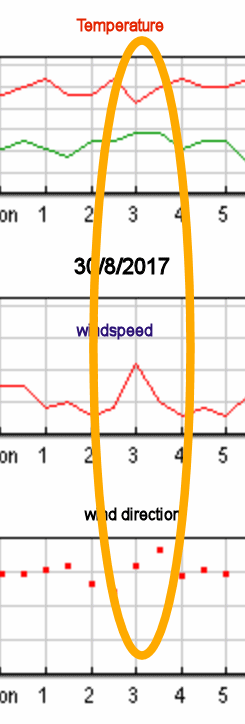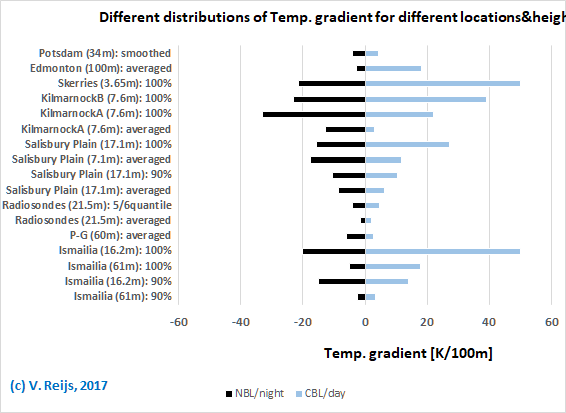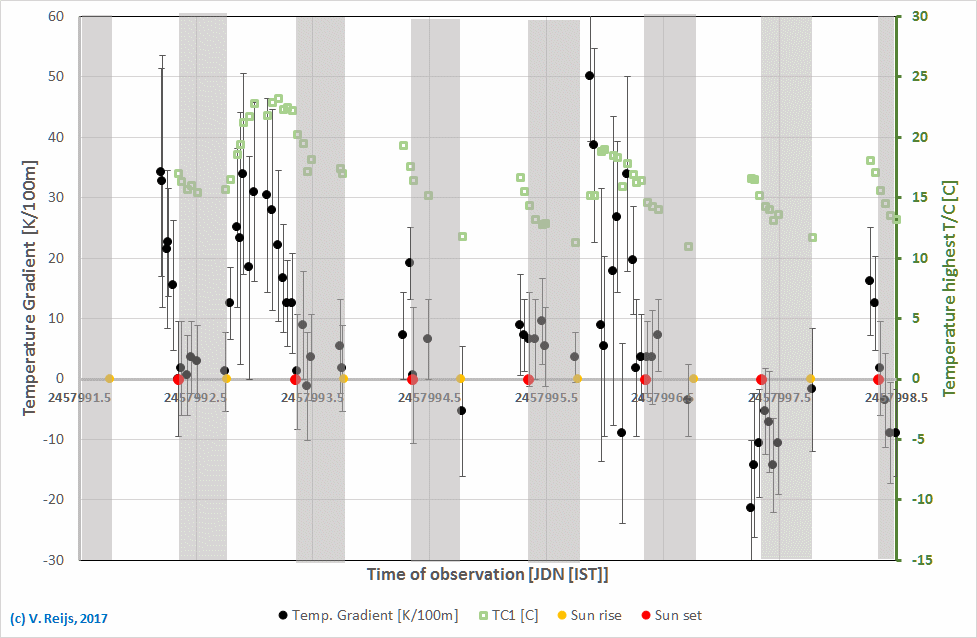Temperature gradients at Skerries
Using two thermo couples (TC) and a thermometer (Signtek 6802 II,
which can measure the temperature difference) the temperature
gradient was measured for a few days near a house wall. The height
of TC2 was at around 0.85m (from a cement surface and
hanging in plants) and TC1 was at a height of 3.65m,
2.8m above TC2. The TCs were some 50 cm from the house
wall. The house wall could reflect heat or be a heat sink/source.
No cars or people can get near the location. The TCs are not
aspirated and are not protected from rain and Sun's irradiance on
the TC by using for instance a gill setup. This is planned to the
near future, using this method.
If the Sun is visible, it can touch the TCs between Sunrise
(around 6:30) and 4 hours later when the Sun goes behind the house
(until around 10:30). In most instances clouds were though
present.
Weather information near Skerries, Ireland (Dublin airport is
some 20km to the South) can be found here.
Make sure one understands the ins and outs of TC measurements. A
good introduction on TCs and their errors, please read here and here.
So this is not a free standing environment (which might be needed
for a 'laboratory' circumstance). But this setup might also
provide an idea of the variability and a real live situation near
an ancient monument.
The measurements
Some 80 measurements have been done over six days at Skerries,
Ireland (some 400m from the Irish sea).
The minimum, maximum and averaged temperature differences (T1
- T2) were derived over a period of at least 10 minutes.
The aim was to measure every hour, but due to work and sleep this
was not always possible. The average values within this period of 10
minutes are quiet stable (so no real drift). The difference
between minimum and maximum value have been used to give an idea of
the error: assumed to be a difference of 6 sigma.
From these temperature values, the temperature gradients are derived
(divided by the height difference [2.8m] and times 100m). The
temperature and the average temperature gradient (including 1sigma
error bars) are provided in below picture (grey areas are night
times):
Other atmospheric parameters (pressure, wind speed, wind direction
and humidity) are recorded as per Wunderground's Dublin Airport data. The cloud
cover, cloud height and temperature at the location and moment of
observations are also recorded. This makes sure the important
parameters around boundary layers
and NRI Stability Classes are
available.
Some points that came up during the
measurements:
- When it rained the temperature gradient changes considerable:
does the rain revert the temperature gradient, because the rain
comes from a region with 'opposite' temperature? Or is it the
rainwater changing the readings? Will make some test to check
the influence of water on a TC reading.
- There are a recognisable dips in the temperature gradient
around 2457996.146 JDN (August 30th 15:30 IST) and around
2457997.253 JDN (August 31st 16:30-18:00 IST). These
coincide with temporarily temperature and/or wind
speed/direction changes (see below) at the location Dublin
airport. So this does not look to be (only) a local artifact.
 |
 |
Temperature and wind
change on August 30th
|
Temperature and wind
changes on August 31st |
Comparison with other sources
Below are the temperature gradients seen in other sources:

In the label the location is mentioned first in each row:
- Potsdam (Knoch, 1909)
- Edmonton (Sampson, 1994)
- Skerries (Reijs, 2017b)
- KilmarnockB (Thom, 1956 and Reijs,
2017a)
- KilmarnockA (Thom, 1958)
- Salisbury Plain (Johnson, 1929)
- Radiosondes (pers. comm. Tschudin 2017)
- Pasquill-Gifford (P-G) stability class (ARCHAEOCOSMO, 2006)
- Ismailia (Flower, 1937)
After the location, the highest height used to determine the
temperature gradient is given (e.g. 7.6m for Thom's).
The average Temperature gradient (measured between 0, and 11km using ISA) is
-0.65K/100m (lapse rate is 0.65K/1km).
The lower the highest height
(normally meaning a smaller height difference for measurements): the
larger variation of temperature gradient will be, e.g. Skerries (e.g
height difference 2.8m).
Sites that are in a warmer climate have a tendency to have larger
variations: e.g. Ismailia under same height difference.
After the height, one can see if the bar is showing the min&max
values (100%), the averaged/smoothed or with bottom&top 5%
removed (90%).
It looks that averaged, smoothed and 90% have similar values. The
100% bars have a higher variability: compare Ismailia 100% and 90%.
Also interesting to see that sometimes the positive gradient is
larger than the negative gradient (depending on location, height
and/or sample).
Conclusions
The Temperature Gradient varies between -22 to 50 [K/100m] in
Skerries Ireland in the month August. Again this is not a laboratory
environment (near a wall and a small height difference) and it is
only over a period of a few days. The variation though is not that
far off compared to other measurements.
The temperature gradient near sunset and sunrise looks to be close
to the expected value of around 2.5 K/100m and a wind speed of
around 2 to 4m/s (Stability
Class E).
More analysis of temperature gradient measurements (incl. air
pressure) can be seen on this web page.
References
Flower, W.D. 1937. 'An investigation into the variation of the lapse
rate of temperate in the atmosphere near the ground at Ismailia,
Egypt.', Geophysical memoirs, Vol 71.
Johnson, N.K. 1929. "A study of the vertical gradient of temperature
in the atmosphere near the ground." in Geophysical memoirs, Vol 46.
Meteorological Office.
Knoch, K. 1909. Ein Beitrag zur Kenntnis der Temperatur- unde
Feuchtigkeitsverhaltnisse in verschiedener Hohe uber den Erdboden
(Berlin: Springer-Verlag).
Reijs, Victor M.M., 2017a, "Geniet: Thom's terrestrial refraction
observations", http://www.archaeocosmology.org/eng/Thom-refraction.htm
Reijs, Victor M.M., 2017b, "Geniet: Temperature gradients at
Skerries", http://www.archaeocosmology.org/eng/TempGradientSkerries.htm
Thom, Alexander. 1956. "Notebook.", MS/430/64, Edinburgh: Historic
Environment Scotland.
Thom, Alexander. 1958. 'An empirical investigation of atmospheric
refraction', Empire Survey Review, Vol 14: pp. 248-62.
Acknowledgements
I would like to thank people, such as Marcel Tschudin
and others for their help and constructive feedback. Any remaining
errors in methodology or results are my responsibility of
course!!! If you want to provide constructive feedback, let me know.
Disclaimer and Copyright
 Home
Home Up
Up Search
Search Mail
Mail
Major content related changes: August 30, 2017



